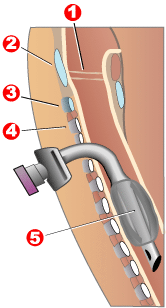
Photo from wikipedia
OBJECTIVE To identify risk factors for temporary tracheostomy tube placement (TTTP) following surgery for alleviation of signs associated with brachycephalic obstructive airway syndrome (BOAS) in dogs. DESIGN Retrospective case-control study.… Click to show full abstract
OBJECTIVE To identify risk factors for temporary tracheostomy tube placement (TTTP) following surgery for alleviation of signs associated with brachycephalic obstructive airway syndrome (BOAS) in dogs. DESIGN Retrospective case-control study. ANIMALS 122 client-owned dogs with BOAS that underwent surgery to alleviate clinical signs (BOAS surgery). PROCEDURES The medical records database of a veterinary teaching hospital was searched to identify dogs that underwent BOAS surgery from January 2007 through March 2016. Of the 198 dogs identified, 12 required postoperative TTTP (cases); 110 of the remaining 186 dogs were randomly selected as controls. Data regarding signalment and select preoperative, intraoperative, and postoperative variables were extracted from the medical record of each dog. Variables were compared between cases and controls and evaluated for an association with the odds of postoperative TTTP. RESULTS Body condition score, tracheal diameter-to-thoracic inlet ratio, staphylectomy technique, and mortality rate did not differ significantly between cases and controls. The odds of postoperative TTTP increased approximately 30% (OR, 1.3) for each 1-year increase in patient age. Postoperative administration of corticosteroids and presence of pneumonia were also positively associated with the odds of postoperative TTTP. Median duration of hospitalization was significantly longer for cases than controls. CONCLUSIONS AND CLINICAL RELEVANCE Age was positively associated with the odds of TTTP in dogs after BOAS surgery, and TTTP led to prolonged hospitalization. Thus, early identification and intervention may be beneficial for dogs with BOAS. The associations between TTTP and postoperative corticosteroid use or pneumonia were likely not causal, but reflective of patient disease severity.
Journal Title: Journal of the American Veterinary Medical Association
Year Published: 2018
Link to full text (if available)
Share on Social Media: Sign Up to like & get
recommendations!